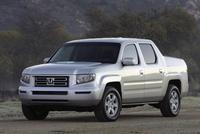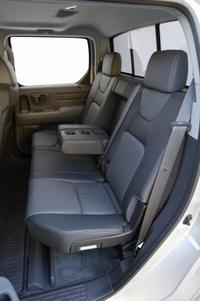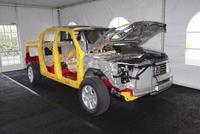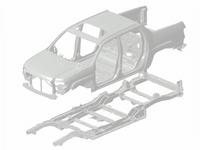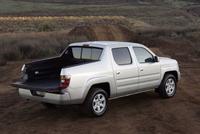2006 Honda Ridgeline RT Review
DRIVING DOWN THE ROAD
WITH CAREY RUSS
SEE ALSO: New Car Buyer's Guide for Honda
2006 Honda Ridgeline RT
Think of Honda, and what comes to mind? Economical yet energetic small cars? Yes. Comfortable and commodious mid-size cars? Yes again. High-performance motorcycles? Absolutely. Small and mid-size crossover SUVs? Indeed. And lawnmowers and portable generators and outboard motors, even.
But not pickup trucks.
Until now. Until the 2006 Honda Ridgeline.
Not surprisingly, the Ridgeline is a very different sort of vehicle than any other pickup. By some conservative definitions of pickup, it isn't even a ``real'' pickup. Unlike any other mid- or full-size pickup truck ever built, it is not made with body-on-frame construction, but with car-like unibody construction, a derivation of Honda's ``Global Light Truck'' platform like the Pilot SUV, but with 93 percent of the structural components transformed. The lower part of the structure is comprised of seven high-strength steel crossmembers that create a fully-boxed ladder frame integrated into the structure. Relative to the Pilot, no sheetmetal is shared, and only five percent of the interior is the same. Its pickup bed is comparable in size to that of a crew-cab compact truck, and no other truck has the Ridgeline's extremely useful locking ``In-Bed Trunk''(tm) underneath the rear of the bed and its convenient dually-hinged tailgate. Open it conventionally, with hinges on the bottom, or with hinges on the side, as needed. And, with the tailgate down, the bed is long and wide enough to hold two off-road motorcycles or one ATV.
Power is supplied by the 3.5-liter V6 also found in the Ridgeline's platform mates, but revised for improved hauling and towing abilities. Three trim levels, RT, RTS, and RTL, are offered. All feature Honda's VTM-4 automatic four-wheel drive system and a locking rear differential for medium-duty off-road abilities. Even the RT is very well-equipped, with all of the important mechanical and safety systems of the more upscale models. The RTS and RTL add comfort, convenience, and even luxury features.
Which is not to imply that the RT lacks comfort. I've just finished a week with one, which was, unlike most press fleet vehicles, equipped with absolutely no options. None seemed needed, really. The Ridgeline does not feel like a pickup at all. Yes, modern pickups are getting ever more comfortable, but the compact and mid-size ones still feel like trucks, primarily because of their relatively light weight and heavy leaf-sprung live rear axles. The Ridgeline, with its independent rear suspension and rigid unibody construction, feels like a modern midsize crossover SUV - a Pilot, in particular - not a truck. It is very close to a car in ride comfort. Yet it can do all the usual truck things, and adds that oh-so-useful In-Bed-Trunk and dual-position tailgate to its roomy and comfortable interior. It will be interesting to see how it does in the market, and to see how long it takes the competition to play copycat.
APPEARANCE: Excuse the irresistible punning, but there is something a little Elemental about the Ridgeline's boxy styling. That's from the squarish, chiseled lines at the front and on the bulging bull-nosed grille and hood. Prominent rectangular fender flares and two longitudinal indentations on the doors continue the industrial look. This is a big Honda, although it's shorter than any compact or mid-size crew-cab pickup. The cab is nearly centered, and high bed sides that slope towards the rear give a look that is closer to larger ``sport utility trucks'' than to a traditional pickup. The Ridgeline sits high, with 8.2 inches of clearance. The RT has steel wheels, while the RTS and RTL have aluminum alloy wheels.
COMFORT: Looks don't lie. The Ridgeline's large exterior size and boxy contours make for plenty of interior space. It's larger than any comparable pickup or sport-utility truck in volume, and also much larger than an Accord sedan - and that's not counting luggage space. There is more than ample room for five people, with the convenience of four door access. Styling is contemporary, a little busy visually but very functional. At the RT trim level, upholstery is a high-grade cloth and the seats are manually-adjustable, and very similar to a similarly-equipped Accord for comfort. Windows, mirrors, and door locks are power-assisted in all trim levels. The rear seat is split 60/40, with cushions that flip up. A golf bag can fit underneath, or a mountain bike can fit inside with both cushions up, if its front wheel is removed. There are convenient small and not-so-small storage spaces galore throughout the cabin, but the best storage feature is underneath the cargo floor. Open the tailgate - it's easier using the side hinges for this purpose - and unlock the panel that covers the 8.5 cubic foot In-Bed Trunk. Inside is a space-saver spare (a full-size spare is available and will fit) and room for several golf bags, or at least two archtop guitar cases, or a large cooler, or any number of large items you will want safe from prying eyes but not necessarily in the cabin. The bed is made of strong sheet-molded composite (SMC) material, which also serves as a built-in bedliner. At five feet long (tailgate up) or six and a half feet with the tailgate down, and with over four feet between the wheel wells, it compares well with the competition, and if something won't fit, a trailer may be a better solution anyway. With a 5,000-lb towing ability, a trailer isn't likely to pose a problem to the Ridgeline.
SAFETY: The Ridgeline scored a five-star rating for safety in both frontal and side impact tests recently conducted by the National Highway Transportation Safety Administration (NHTSA). It is the first four-door pickup to do so. All models come with dual-stage front, front side, and side curtain airbags, Vehicle Stability Assist (VSA) and traction control, antilock four-wheel disc brakes, and brake assist.
ROADABILITY: It looks like a pickup, it works like a pickup, but on the road, the Ridgeline doesn't even feel like a pickup. Its modified unibody construction eliminates any squeaks or rattles from a separate body and frame reacting differently to suspension inputs, allows greater space efficiency, and improves passenger safety in an accident. Most importantly, the Ridgeline has independent rear suspension, a pickup first. In a conventional pickup, inertial forces caused by the large amount of unsprung weight in the rear axle, differential, wheels and tires require stiff springs and shocks to control, producing the standard jouncy, stiff pickup ride. The Ridgeline's lighter independent multilink rear suspension does a much better job of controlling the wheels, for truly car-like ride and handling characteristics. It's designed for everyday use on pavement, and up to medium-duty off-road use. As on the Honda Pilot and Acura MDX, the VTM-4 automatic four-wheel drive system operates with a front-wheel drive bias normally, sending power to the rear wheels when needed. I didn't drive the Ridgeline off road, but I have driven MDXes in slick mud and in snow, where they performed well, so I would expect similar abilities from the MDX. Equipment for really heavy-duty off-road excursions can be carried in the bed, in the form of a mountain bike, ATV or dirt bike.
PERFORMANCE: Pickups usually have some incredible number of optional engine and driveline configurations, and here Honda is also different. Power for the Ridgeline is simple - a version of the 3.5-liter single overhead cam 24-valve alloy V6 that also serves in its platform-mates. Matched to a five-speed automatic transmission and Honda's VTM-4 automatic single-range four-wheel drive system, the engine has been modified slightly, to better fit with the towing and hauling uses of the Ridgeline. Thanks to the VTEC variable valve timing and lift system, the engine has very good low- and mid-range response, with maximum horsepower of 255 at 5750 rpm and 252 lb-ft of torque at 4500 rpm. It's smooth and civilized, and allows the Ridgeline good highway performance to go with its muscle.
CONCLUSIONS: Leave it to Honda to reinvent the pickup truck, in the form of the 2006 Ridgeline.
SPECIFICATIONS
2005 Honda Ridgeline RT
Base Price $ 27,700
Price As Tested $ 28,215
Engine Type single overhead cam 24-valve
aluminum alloy V6 with VTEC
variable valve timing and lift
Engine Size 3.5 liters / 212 cu. in.
Horsepower 255 @ 5750 rpm
Torque (lb-ft) 252 @ 4500 rpm
Transmission 5-speed electronically-controlled
automatic
Wheelbase / Length 122.0 in. / 206.8 in.
Curb Weight 4503 lbs.
Pounds Per Horsepower 17.7
Fuel Capacity 22 gal.
Fuel Requirement 87 octane unleaded regular gasoline
Tires P245/65 SR17 Michelin LTX
Brakes, front/rear vented disc / solid disc,
ABS and Brake Assist standard
Suspension, front/rear independent MacPherson strut /
independent multi-link
Ground Clearance 8.2 inches
Drivetrain front-engine, automatic single-range 4-wheel drive
PERFORMANCE
EPA Fuel Economy - miles per gallon
city / highway / observed 16 / 21 / 17
0 to 60 mph 8.0 sec
Payload 1,100 lbs.
Towing Capacity 5000 lbs.
OPTIONS AND CHARGES
Destination and Handling $ 515



